SEO for Beginners: The Complete Guide
New to SEO? Our SEO for beginners guide offers a step-by-step overview to understanding how Search Engine Optimization (SEO) works, how to grow traffic, rank well on Google and other search engines, and get more online revenue.
July 31st, 2017 | By: Jacob Stoops | Tags: Development, Search Engine Optimization (SEO)
As a startup founder, one of the biggest keys to success is being able to leverage marketing to garner awareness and grow your business. This means taking stock of all potential marketing channels and deciding which ones are the best fit for you.
Chances are, especially if you’re bootstrapping, that digital marketing is the first thing that came to mind. In general, the barrier to entry with digital marketing is much lower and there are many ways for you to market yourself for free—if you’re willing to dedicate the time and energy.
SEO For Beginners
Enter SEO — One of the most cost-effective ways to get your startup some exposure
If you’re new to SEO, or if you are needing to brush up on your skills, you’re in the right place. Our SEO for beginners guide will provide you with a comprehensive understanding of:
- How search engines work
- What it takes to make your site search-friendly
- How and where to begin optimizing so that your website can rank well, and begin growing digital revenue.
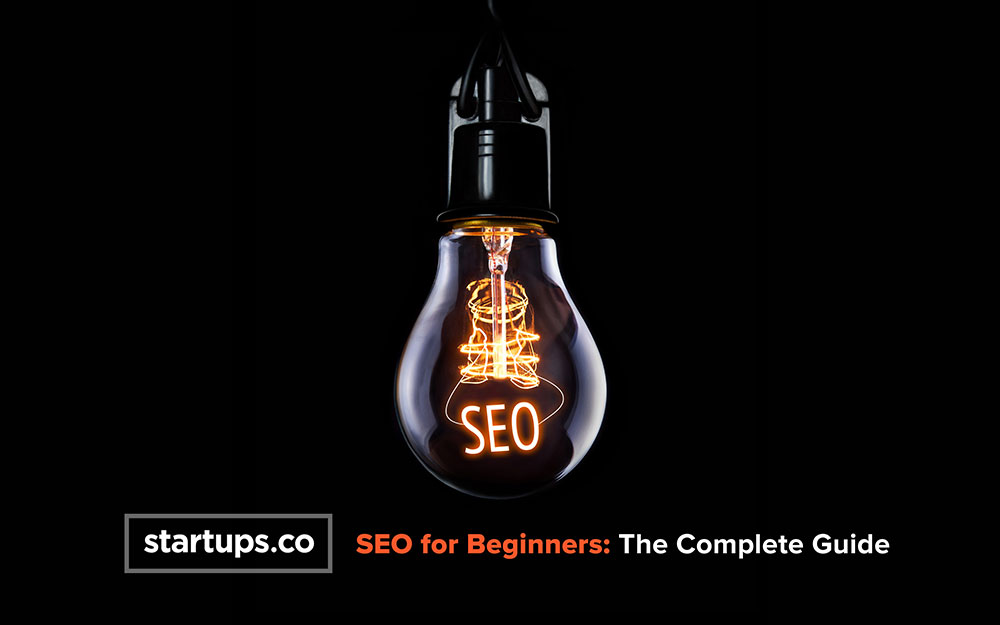
Table of contents:
- What is Search Engine Optimization (SEO)?
- How Do Search Engines Work?
- What Search Engines Are Most Important?
- What Things Affect Your Rankings?
- How Long Does SEO Take To Be Successful?
- Should You Do Pay-Per-Click (PPC) Instead?
- Should You Do-It-Yourself, Outsource, or Insource?
- What Are The Basic Pillars of An SEO Strategy?
- What Happens If You Try Gaming the System?
- How Do You Know You’re Doing Well?
- What Are The Best SEO Tools & Resources?
- Conclusion
What is Search Engine Optimization (SEO)?
Here’s a textbook definition:
Search Engine Optimization, or SEO, is the process of enhancing a website’s visibility in search engines – specifically in the organic (unpaid) portion of search results.
And now, here’s a translation in layman’s terms:
SEO is the process of optimizing your site, it’s content, and your overall digital footprint so you can show up higher on search engines like Google, Bing, etc., and thus get more free traffic.
Let’s take that a step further…
You have things that you do as a business, and those things are likely to be the things that you’d want to show up – or rank – for if someone searched for them on Google.
For example, if your startup makes “sprockets,” then you’d want to show up in Google any time someone searches “sprockets.”
That’s where SEO comes in.
SEO is the process (or the magic, so to speak) of ensuring your site content is optimized for “sprockets”, so that you’re more likely to show up amongst top search engine results when someone searches for that term.
How Do Search Engines Work?
In order to understand SEO, it’s important to understand how a search engine like Google works in the first place.

For a typical query, there are thousands, even millions, of webpages with potentially relevant information.
Google has put together a really great guide detailing “How Search Works” and there is also a great – albeit dated – video from Matt Cutts laying it out:
Essentially, there are 3 main functions of a search engine:
Crawling and Indexing
Search engines find information by crawling the web. They crawl the web using robots (often called “web spiders” or “web crawlers”), who crawl from site-to-site, link-to-link, in an effort to find as much information on the web as possible. This includes finding net new sites, checking old pages, etc.
They then take all of the pages they crawl, gather them up, and bring it all back to their servers for storage in their index which includes hundreds of billions of webpages and is well over 100,000,000 gigabytes in size.
Think of it in the same way you would a book, but with an entry for every word seen on every web page they index.
Ranking Results
So, what do they do with all of that information? The process looks something like this.
A user goes to Google and types in a search query such as “sprockets.” Faster that you can blink an eye, Google combs through all of the websites and pages within their search index and determines which pages they believe are relevant for “sprockets.”
From there, they instantaneously rank all of the relevant pages (which many times number in the millions) from most relevant to least relevant.
How do they do this? Well, they have developed a highly sophisticated algorithm which includes over 200 different ranking factors that they evaluate every single webpage against in an effort to determine what they think will be most relevant to the person typing in the search query.
Serving Useful Content
Once search engines have analyzed all relevant pages and parsed them them through their ranking algorithm, they will return the pages in their Search Engine Results Page (SERP), ordered from most relevant to least.
The general principle is that it’s best to rank higher on a SERP than lower.
This is because the higher the result appears on the page, the more clicks it generally gets. For example, a 2014 study showed that the first 5 results in Google get 67% of all clicks. Despite the fact that a #1 result in Google may have diminished by up to 37% over the past two years, the general principle still applies and organic can still be a very high traffic-driving channel.
A typical SERP includes paid search results as well as unpaid, but it’s important to note that SERP layouts and format are continually evolving in terms of how organic information is being displayed including rich snippets, images, videos, direct answers to questions, social media results, Knowledge graphs, and more.
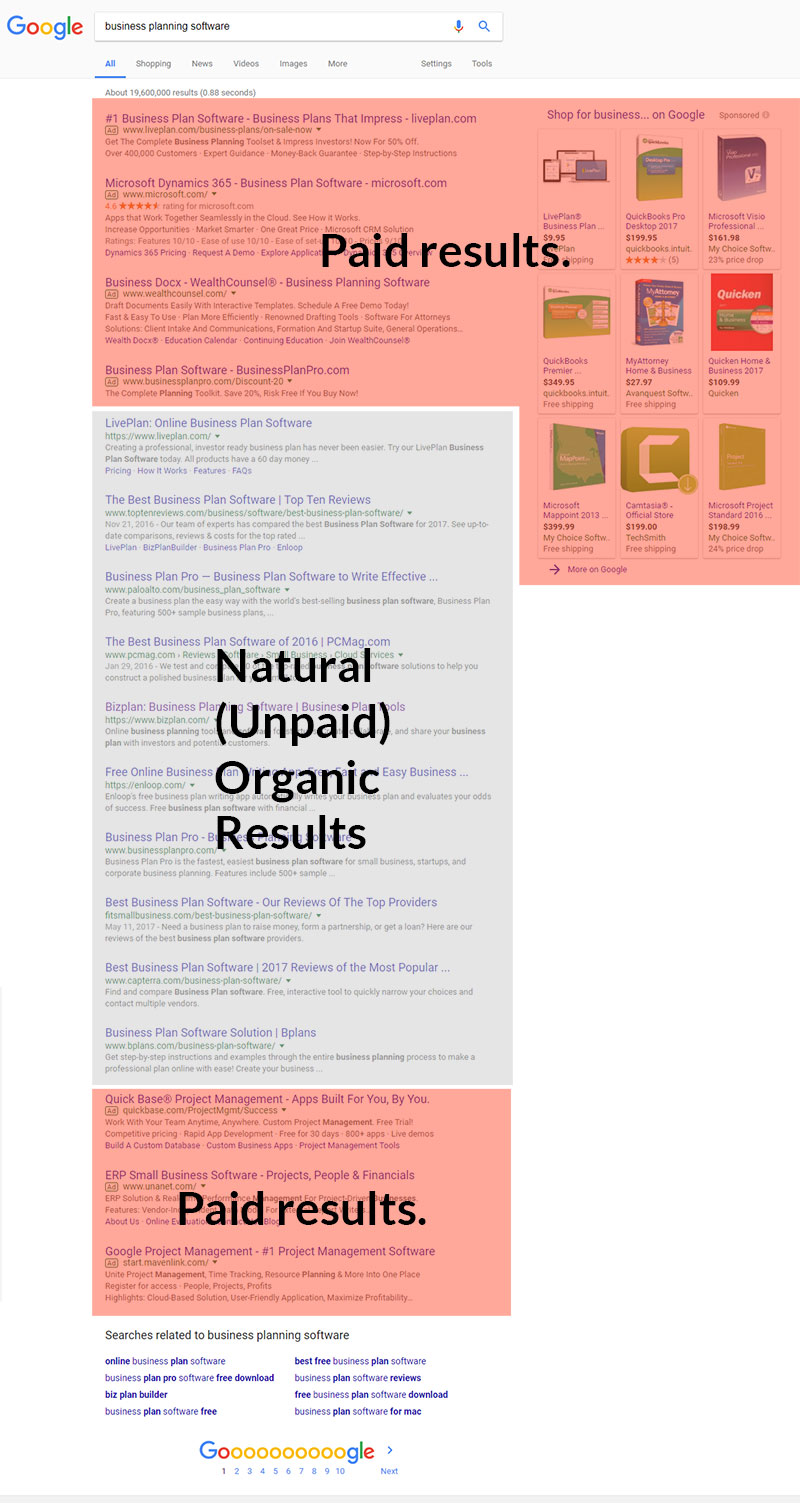
Which Search Engines Are Most Important?
Let’s get real. When we’re talking about search engines and SEO, we mostly mean Google.
That’s because Google has the most market share and therefore delivers the most organic traffic in most cases. To put it in perspective, according to Search Engine Journal-StatCounter, Google had:
- 79.88% market share on desktop (Bing was second at 9.9%)
- 94.53% market share on mobile (Yahoo! was second at 4.07%)
- 85.82% overall search market share (Yahoo! was second at 6.99%)
That’s domination almost to the point of monopoly, and it’s not likely to change in the near future. Therefore, I’d recommend focusing most of your optimization efforts on Google and tailoring things to their algorithm.
The good news is that Google is relatively progressive with their algorithm and most of the other sites tend to follow behind, so if something is good for Google it usually is good for other search engines like Bing, DuckDuckGo, etc.
The only real outliers to this ideology would be International search engines such as Yandex, Baidu, and other region-specific search engines.
What Things Affect Your Rankings?
Given what we mentioned above about Google having 200+ ranking factors, by definition there are many things that can affect how well your site ranks.
To break it down to it’s most basic definition, there are basically two things that can impact how well you rank:
On-Site (e.g. Things Occurring On Your Site)
This includes the content on your site, the words that you use, how technically accessible your site is, how fast it loads, how good your user experience, site architecture, and design is, and so on and so forth.
Off-Site (e.g. Things Occurring Away From Your Site)
This essentially means things that are occurring that impact your rank, but that aren’t actually occurring on your site. For example: Whether or not other websites link to your site, social media, other digital marketing, online and offline PR, and overall chatter about brand, site, etc.
Google has said as recently that their top 3 ranking factors are (1-2) Content and Links, and (3) something called Rank-Brain which we won’t go into here.
How Long Does SEO Take To Be Successful?
You won’t like this answer— but, this depends on several factors including:
- The scope of the site and the engagement (because they’re different)
- The complexity of the brand and website
- The level of maturity of any legacy or current marketing campaigns including past or current SEO strategies
- Any time needed to undo legacy recommendations and/or penalties
- The speed of strategic development and execution
- The complexity of implementation of recommendations
- The amount of red-tape any recommendations have to pass through
- The expectations of what success looks like (which can vary)
Generally speaking, with a clear runway, an SEO strategy should begin bearing fruit in 6-12 months which may seems like a long time, but when you consider in some cases the barriers and sweat equity that can be involved, the timeline begins to add up.
Google came out with a great video entitled ‘How to hire an SEO’ which further elaborates on what SEO success looks like:
Some stand-out words of wisdom from former Googler Maile Ohye:
“To some, SEO seems like black magic. Having worked with Google search for over a decade, what I’ve learned is that first, it’s not black magic. And second, if you want long-term success, there aren’t any quick magical tricks that an SEO will provide so that your site ranks #1.”
“It’s important to note, that an SEO’s potential is only as high as the quality of your business or website. So successful SEO helps your website put your best foot forward so that it ranks appropriately in a spot where an unbiased potential customer would expect your site to be seen. A successful SEO also looks to improve the entire searcher experience from search results, to clicking on your website, and potentially converting.”
“In most cases, SEO’s need four months to a year to help your business first implement improvements and then see potential benefits.”
Should You Do Pay-Per-Click (PPC) Instead?
To be 100% frank, SEO is more of a long-term investment whereas Pay-Per-Click and other forms of paid advertising will garner quicker wins in the short-term.
Not only that — but SEO, while not exactly rocket science, does take a lot of sweat equity — whereas a PPC campaign can probably be up and running in a few hours or days in most cases.
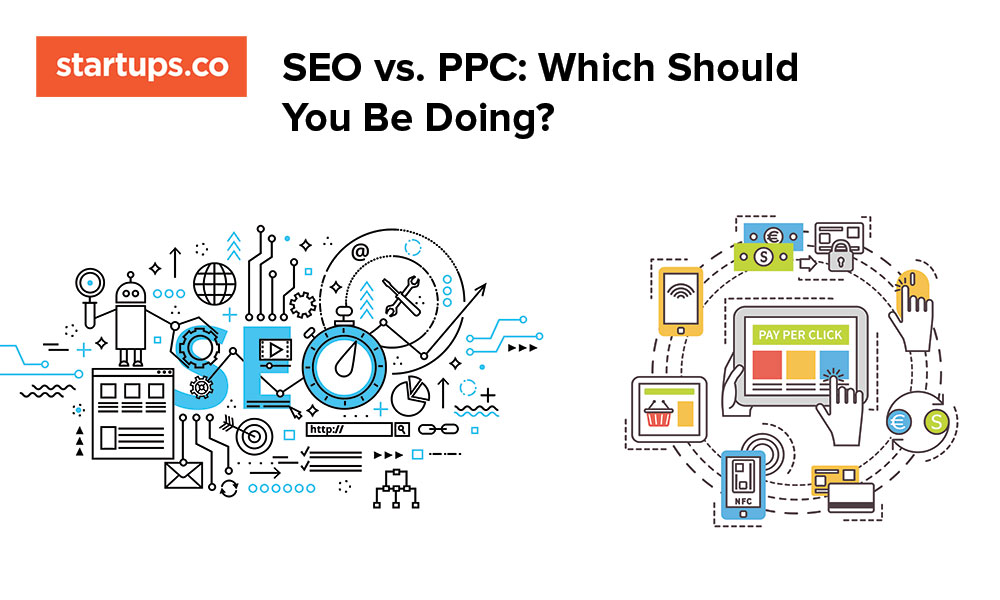
So why waste time with SEO when paid is so much quicker?
It’s simple. PPC is a pay-to-play system. If you want money out, you have to keep putting money in.
With SEO, you can’t pay your way into the organic search results. If you earn a particular rank, that search placement/traffic is for all intents and purposes free (and yours until someone can unseat you) minus your own sweat equity or what you might pay someone else of course.
In terms of money or marketing budget, SEO is usually the most efficient long-term marketing channel when you consider the spend and sweat equity put in compared to the end result. I’d liken it to a good 401k whereas PPC is more like an aggressive short-term stock.
Weighing short-term vs. long-term
This is not to say that PPC is bad. The opposite is true, PPC is a very good source of digital exposure. In fact, SEO and paid search typically compliment each other quite well if used in harmony.
This is just to say that if you’re weighing which channels to focus your marketing efforts on as a startup or bootstrap, it’s important to have a good understanding of timelines to both market and to be successful both short and long-term.
Should You Do-It-Yourself, Outsource, or Insource?
There are certainly pros and cons to each approach, and in the end you have to pick the approach that best fits for your startup business.
Do-It-Yourself (DIY) SEO
If you’re feeling froggy, SEO is absolutely something that you can do on your own, and you absolutely can be successful. And if you’re considering doing all of your own SEO, that’s great. More power too you. But before you do, I’d ask you to consider this:
—Do you have the time?
—Do you have enough expertise?
That said, as a startup owner you’re plate is likely very full as it is, and if that’s the case you may need to consider hiring someone.
Outsourcing SEO vs. Insourcing SEO
If you’re considering hiring someone to help you with SEO, there are a few options:
—You can hire a consultant, and then execute their recommendations
—You can hire an agency
—You can hire an SEO to be in-house
—You can assign SEO to someone already in house
Having done and worked with all of the above, here’s are the pros and cons of each as I see them:
Consultants or agencies
- Pros: Likely to have a higher degree of expertise, wider variety of experience, bigger teams, and may be more aggressive to drive success.
- Cons: You are definitely not their only client, they may not know enough about your industry, may have more difficulty getting things executed since they can’t sit with your engineers for example, and may be overly aggressive in an effort to keep you as a client (which may or may not be good for SEO).
In-house SEO’s or assigning SEO to someone already on the team
- Pros: Likely to have a much greater familiarity with the brand/industry, better understanding of internal process and red-tape, better ability to get things executed, likely to be more invested in the brand’s success than someone on the outside
- Cons: May not have as much expertise or experience as an outside consultant or agency, likely to be a much smaller team, and may not be quite as willing to push the envelope for one reason or another
Again, the right answer in terms of how to get your SEO strategy moving is whatever the best fit is for your startup. If that means doing it yourself, can absolutely work! If it means, hiring someone internally or externally, that’s great too!
What Are The Basic Pillars of An SEO Strategy?
You now know that there are things occurring on and off your site that impact how well you perform, so how do you begin laying out an SEO strategy.
If we’re thinking things from an SEO for beginners perspective, I’d lay out a general SEO strategy using five critical pillars for creating both a search-friendly website and an SEO-friendly digital footprint.
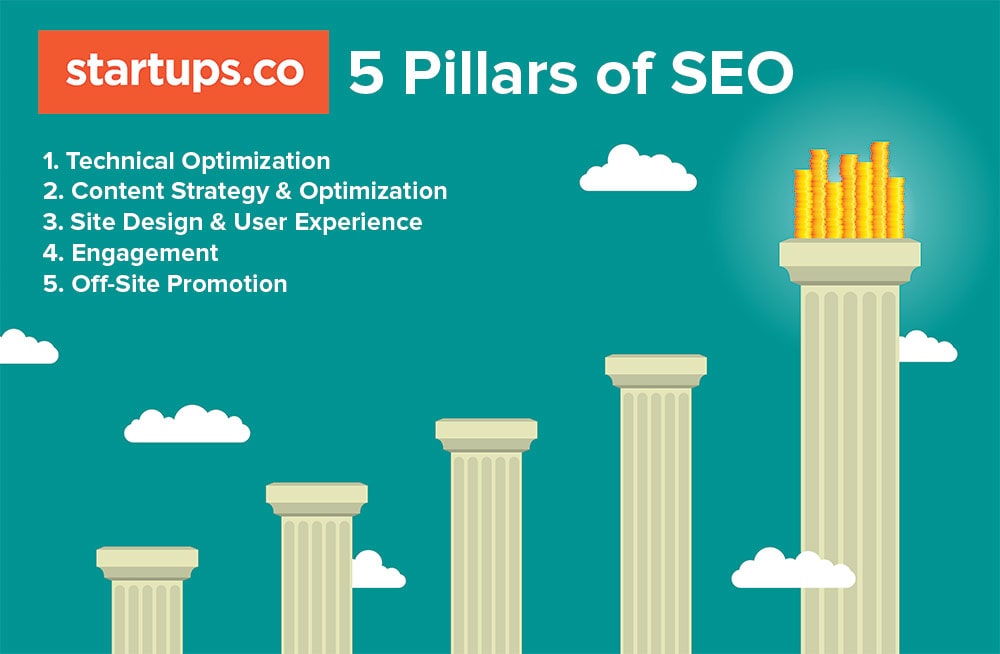
1. Technical Optimization
I consider good technical optimization as kind of a barrier to entry for both an SEO strategy as well as search engines. In this way, it is very similar to the foundation of a house. If your house doesn’t have a good foundation, then the rest of the house is likely to be shaky.
Good technical optimization is first and foremost making sure that Google and other search engines can crawl and index your pages. If they have trouble crawling your content, no matter how awesome it may be, then it isn’t going to show up in organic search results (or it will show much lower than it would otherwise) and kind of defeats the whole process.
Not only that, but good technical SEO also means good technical page set-up, wherein you make your website structurally more sound and crawlable in the eyes of Google.
Looking at a site from a technical perspective will involve diving into things like:
- Root domain (HTTP and HTTPS)
- Servers and response codes
- HTML site architecture
- Robots.txt files and tags
- Title tags
- Meta tags
- Duplicate content including canonical tags
- Structured data
- And much, much more…
2. Content Strategy & Optimization
If having a technically well-architectured site is the peanut butter, then content is definitely the jelly that brings it all together. In terms of being able to perform well for SEO, having content that is helpful to your target customers is almost a MUST. It’s almost a prerequisite for being able to rank at all.
When it comes to content strategy and optimization, this means having content that is highly geared towards what your audience searches for most often, and then ensuring that said content is technically well-optimized once it’s live on your site.
This means doing things like:
- Performing keyword research to find which keywords and phrases are most popular for your industry
- Picking out the phrases that you’ve researched that correspond to what you’d like to rank for in Google
- Creating highly targeted pieces of content that are aligned to your target keywords
- Making sure that your content is well-optimized in terms of actually using target keywords on the page, in page titles, meta, URL, etc.
3. Site Design & User Experience (UE or UX)
Once your site is technically well optimized and you have search-friendly content, the next core pillar is design and user experience.
Some good questions to ask yourself:
- Does the site balance clear navigation and ease of use while at the same time being aesthetically pleasing and representative of the brand? These are not always aligned.
- Are all pages (especially important ones) no more than three clicks away from the homepage? Here’s a great article from Rand Fishkin of Moz on internal linking.
- Does the site’s content load quickly? Google says a site should load in 3 seconds or less or else risk losing potential visitors.
- Is there anything about your site design and UX that might turn a potential customer off or make their experience more difficult?
4. Engagement
Okay, so tech and content are on lock. Assuming site design and UX are in a reasonable place, the next logical step would be to look at engagement.
Ask yourself:
- Once people get to your site, are they engaging with it?
- Are you making it easy for them to engage with?
- Do you have clear paths to conversion?
- Can people share your content?
- Are people able to easily find how to get in touch with you?
- Are users staying (e.g. Long Clicks) or leaving immediately (e.g. a bounce)?
- When people stay, how long are they staying (see: The 59 Second Rule: 3 Reasons Why Users Leave a Website)
If you’re driving boatloads of SEO traffic, but that traffic is not doing what you want – e.g. converting – then it’s highly likely you need to evaluate one or all of the pillars above.
5. Off-Site Promotion
Though inbound links are super important (#1-2 ranking factor in Google), I typically save the off-site promotion pillar for last because it’s one of the most difficult to execute successfully. It requires by far the most effort, can get you in trouble the easiest, and tactically-speaking may require some of the above before getting into.
That said, while the steps above can take you far in SEO, no good SEO strategy is complete without comprehensive off-site promotion.
This means getting exposure for your site in the form of links – which to Google, act as votes of authority for a particular website or webpage.
Google and other search engines look at both the quantity of links to a site or page (e.g. number of votes) as well as the quality of those links. For example, a link to your website from an authoritative site like The Wall Street Journal is probably worth 10x more in terms of SEO equity than a link from a lower-tier site.
Not only that, but Google also looks at the way people link to your site as an indication of phrases you might be relevant for.
To use the example above, if given no other information, Google sees that many websites link to your site using the anchor text “sprockets,” then this is a strong signal to them that your site may indeed be relevant for that phrase.
Therefore, inbound links from highly authoritative (and contextually relevant) websites is highly desirable for SEO. Best case scenario is that this occurs naturally without you having to do anything, but oftentimes it requires sweat equity to make people aware of your content and get them to link to it.
In SEO, the tactic is called link building, and it is the hardest thing to do in SEO because A) the link has to occur on someone else’s site, B) it’s hard to get people to respond to you let alone make the effort to link to you.
Unsurprisingly, because link building is so difficult, it is also the most abused and unscrupulous aspect of the SEO industry. There have been many, many penalties shelled out by search engines and even an animal-named algorithm entirely dedicated to combat spam dubbed Google Penguin.
Long-story short, getting good links should help your rankings and you may have to proactively building them, but the best case is that you do enough marketing-wise to simply earn them naturally – easier said than done.
Not saying you should promote your site and it’s content via all channels, but as a beginner to SEO, I’d highly suggest focusing on the first four pillars before even attempting to delve into link building itself – which is a more advanced and risky form of SEO in my opinion.
What Happens If You Try Gaming the System?
As mentioned many times above, a good SEO is not going to be able to magically get you #1 rankings that your site doesn’t deserve. Any proper SEO strategy is a long-term play designed to squeeze more juice out of the site, as well as to help the site expand to cross the intersection of brand relevance and search demand.
If your desire is to make it to the top quickly and without much effort, then SEO probably isn’t for you. Good SEO doesn’t take shortcuts.
Google’s algorithms are so sophisticated at this point, that even if you do take shortcuts and get a ranking that you didn’t truly earn through artificial means that they will likely catch up to you eventually, and when they do, it won’t end well for your site.
In fact, they have an entire set of Webmaster Quality Guidelines to govern what they believe to SEO tactics that violate the spirit of what they’re trying to do. These include:
- Automatically generated content
- Participating in link schemes
- Creating pages with little or no original content
- Cloaking
- Sneaky redirects
- Hidden text or links
- Doorway pages
- Scraped content
- Participating in affiliate programs without adding sufficient value
- Loading pages with irrelevant keywords
- Creating pages with malicious behavior, such as phishing or installing viruses, trojans, or other badware
- Abusing rich snippets markup
- Sending automated queries to Google
Partake in any of these practices, while you may gain some short-lived SEO value, you’re putting your site on the chopping block for either an algorithmic or manual Google penalty – both of which could have long-term ramifications for your organic visibility.
Here are some sites that have been hit by manual Google penalties and what they did to get in the “penalty box.”
White-Hat vs. Black-Hat
It’s also worth noting that while most SEO’s distinguish themselves as being ‘white-hat,’ there are absolutely areas of the industry where folks absolutely identify as ‘black-hat SEO’s’ such as BlackHatWorld.
The key difference here is that those who identify themselves as being ‘white-hat’ would not knowingly do something that would put a site in position to get penalized, though there are certainly many instances of good SEO’s testing the limits and getting their hands slapped so to speak. Those who identify as ‘black-hat’ make no bones about the fact that they actively violate Google’s quality guidelines to garner their SEO performance – however short-lived it might be.
How Do You Know You’re Doing Well?
In order to know how you’re doing, it’s very important to know where you’re at and where you’ve been. If you learn nothing else from this SEO for beginner guide, learn this…
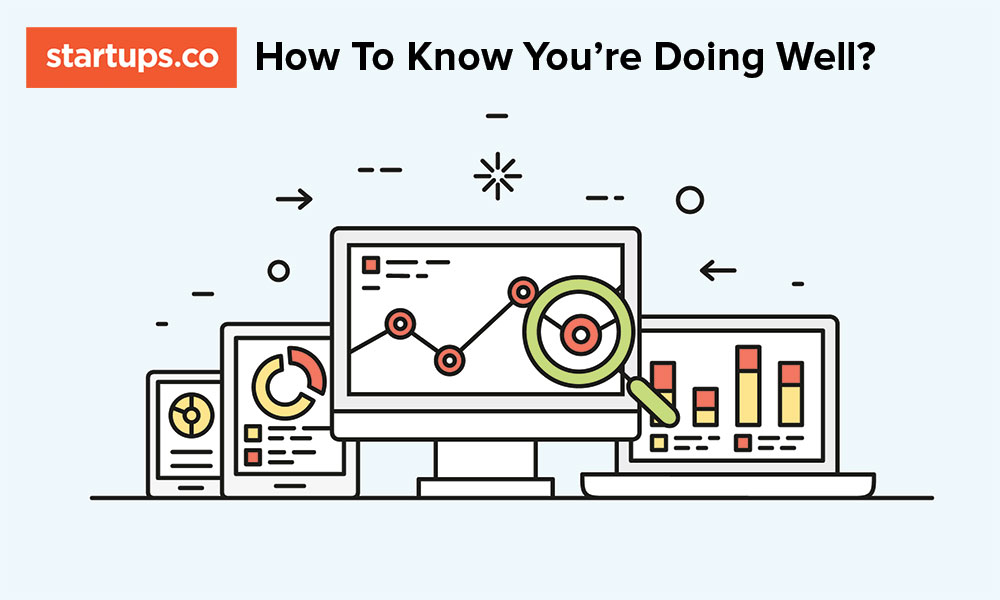
Always be auditing
Whether you’re a beginner to SEO or a seasoned SEO veteran, this proves true. To know where the true opportunities lie for your SEO strategy, it should all begin with an unbiased audit looking at:
Technical optimization audit:
- Is your site crawlable?
- Do you have any indexation barriers?
- Is your server setup optimal?
- Is your site’s HTML optimal?
Content strategy and optimization audit:
- Does your site have the correct content?
- Is your site’s content technically well-optimized?
- Does your site have any content gaps?
This way, you have a solid benchmark and a starting point to measure all activity against going forward – kind of a line in the sand. Before venturing into the other areas, I’d recommend just starting there. Audit those two things and that should give you enough fodder to get your SEO strategy up and running.
Not only that, but your audits shouldn’t be a one-time thing. Depending on the size and complexity of your site, consider several major audits per year. If for anything else, it’s good to A) see what progress you’re making over time, and B) see if any new issues have inadvertently cropped up since your last audit(s).
Always be testing
You never know when a lever that you pull is going to move the needle or worse yet cause the floor to drop out from underneath you.
Not only is it an SEO’s job to grow traffic but to protect it as well.
While I’m not saying that you should be conservative to the point of being scared to implement changes, it’s absolutely prudent to first test things where you’re not certain that the outcome will be a net positive.
Not only that, testing can give you the data you need to push an initiative forward or shut it down if need be.
Always be benchmarking and measuring
Driving more traffic, business, etc. is the end goal, right?
Make sure you’ve got a system in place such as Google Analytics and/or other tools to help you measure the performance of your digital efforts.
Not only that, but you should be regularly benchmarking your data to ensure that you have good before vs. after pictures to measure SEO success against.
What Are The Best SEO Tools & Resources?
In order to do all of the things that you need to do as an SEO, there is a broad range of SEO tools that can help you do things ranging from technical auditing to your website analytics.
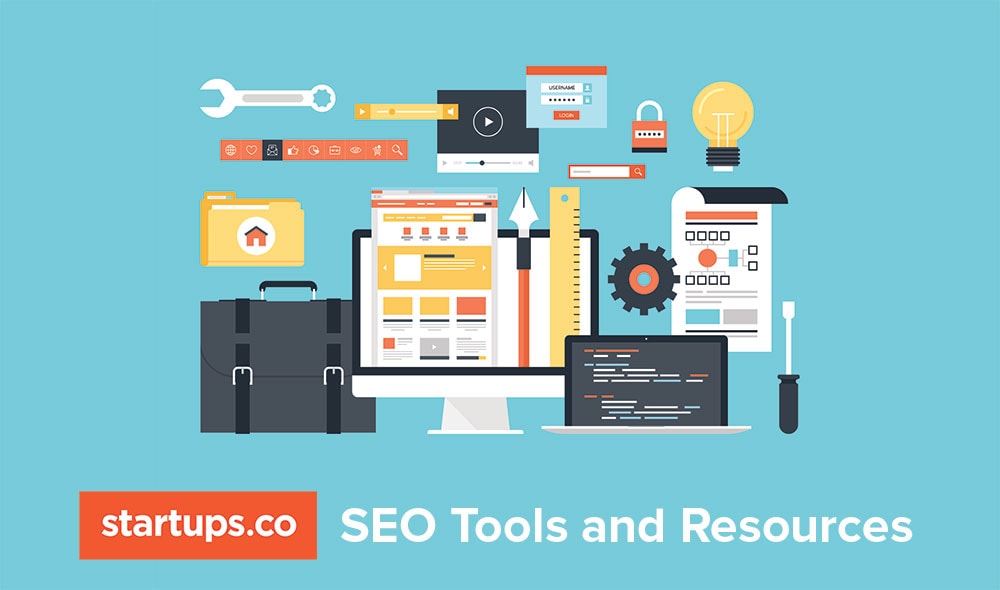
Luckily, we’ve created a list of our 51 favorite paid and free SEO tools to help you with some of that. A few personal favorites from that list include:
- AHrefs (Enterprise SEO)
- Deep Crawl (Technical SEO)
- Google Analytics (Analytics)
- Google Search Console (Technical SEO & Analytics)
- GT Metrix (Site Speed)
- Linkdex (Enterprise SEO)
- Moz (Enterprise SEO)
- Screaming Frog (Technical SEO)
- WebPageTest.org (Site Speed)
While unfortunately there isn’t a single tools that does every single thing you need well, you can pretty easily coagulate some grouping of tools together to get the information you want.
Conclusion
Is SEO hard? Some people would like you to believe it is harder than it really is. That said, there are also some people that would have you believe that it’s much easier than it really is. The answer lies somewhere in between.
Is SEO worth it? As I mentioned above, if done correctly SEO can absolutely grow to be your biggest source of traffic or near the top. Not only that, but that source is not pay-to-pay meaning that it can benefit you over a long period of time and becomes more cost-effective the longer you do it.
SEO is a “zero sum game.” In order to be successful, that often means displacing other websites. Doing that can take lots of hard work and dedication. Like anything else worth doing, there is likely to be a good deal of sweat equity before you begin to grow – and that’s normal. Once you do become successful, while you have to keep working at it, it becomes harder and harder for other sites to get back.
Hopefully, our SEO for beginners guide has pointed you in the right direction, and sent you out the door knowing what the expect and with the correct mindset to drive results!
With that said, if you’ve made it to the end of this article, we can say that you’ve officially graduated and are no longer an SEO beginner. You’re armed to the teeth with loads of valuable SEO ideas and perspectives.
So, as we say in the industry, go forth and optimize!
About the Author
Jacob Stoops
Jacob Stoops is a Senior SEO Manager at Search Discovery, former Director of Search Marketing at Startups.co, as well as former Associate Director of SEO at Razorfish. A long-time digital marketer with over a decade of SEO experience, he's worked with some of the biggest brands in the world to grow their organic traffic. Follow him on Twitter: @jacobstoops or connect on LinkedIn.
Related Articles
Unlock Startups Unlimited
Access 20,000+ Startup Experts, 650+ masterclass videos, 1,000+ in-depth guides, and all the software tools you need to launch and grow quickly.
Already a member? Sign in